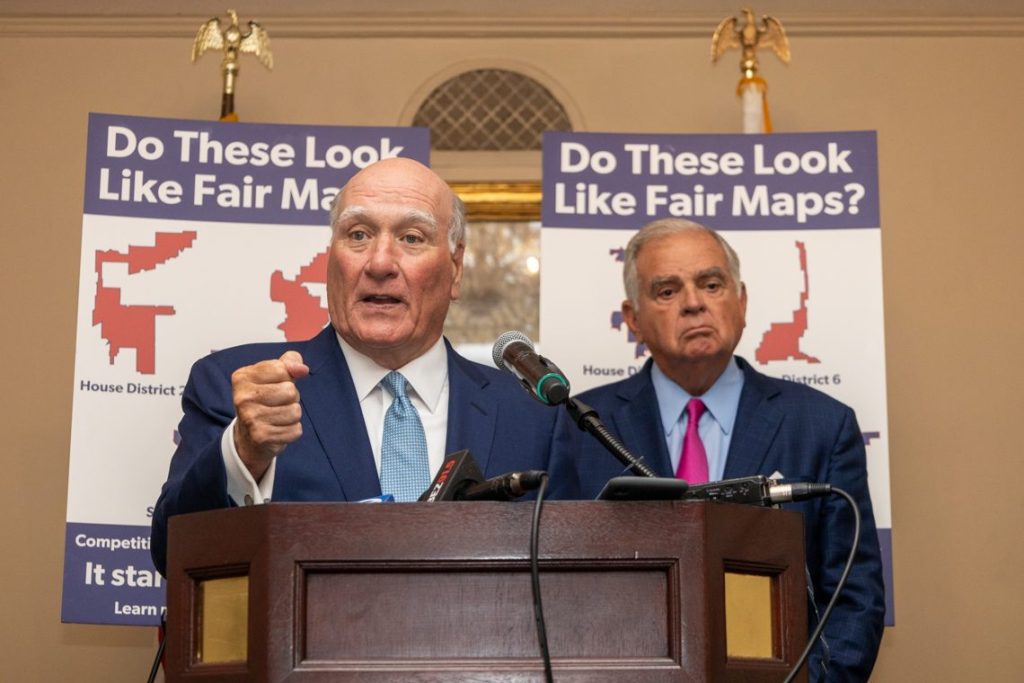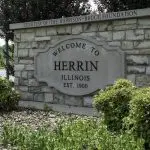
By ANDREW ADAMS
Capitol News Illinois
aadams@capitolnewsillinois.com
Article Summary
- Former federal officials are backing an effort to reform the state legislature’s redistricting process. Congressional districts would be unaffected.
- Illinois’ state Senate map gives a partisan advantage to Democrats, and its House map isn’t compact enough, according to researchers at Princeton.
- Ray LaHood and Bill Daley hope to get a constitutional amendment on the ballot in November 2026, but they’ll need hundreds of thousands of signatures and millions of dollars to do so.
- Past efforts to reform legislative redistricting, most notably in 2016, failed after ballot measures were thrown out by state courts.
This summary was written by the reporters and editors who worked on this story.
CHICAGO — A group of former Obama administration officials and election lawyers announced Tuesday they are attempting to reform the way the state draws district maps for the state legislature. They want to do this by passing a state constitutional amendment via a ballot initiative during the 2026 general election.
They say the current legislative redistricting process leads to overrepresentation of Democrats and few competitive legislative districts, meaning politicians must do less to serve their constituents.
Former U.S. Secretary of Transportation Ray LaHood, a Republican, and former Secretary of Commerce Bill Daley, a Democrat and member of the Daley political family, are leading the effort. Both served under President Barack Obama, with Daley as his chief of staff.
Former State Board of Elections Chair Bill Cadigan and election lawyer Michael Dorf, whose past clients include the Democratic Party of Illinois and several sitting statewide officials, also are backing the effort.
Twelve Member Redistricting Commission
The proposal would create a 12-member “Legislative Redistricting Commission,” appointed by the top Democrat and Republican in each legislative chamber. Each legislative leader would appoint one member of the General Assembly and two members who are not lawmakers.
Commissioners would be barred from considering political party registration or voting history data when drawing maps. Districts also would be required to be compact, contiguous and drawn along existing county and municipal lines where possible.
The amendment would only apply to the redistricting process for the state legislature. It would not apply to congressional districts, which would still be drawn by state lawmakers.
The amendment would also change the size of the state legislature, so that if the state’s population significantly increases or decreases, so too would the number of districts.
This model is based on Iowa, Arizona and Pennsylvania. The Princeton Gerrymandering Project, which analyzes how severely gerrymandered states’ legislative maps are, gives Illinois a “B” grade for the state House and an “F” for the state Senate. Iowa and Arizona received A grades for their state maps and Pennsylvania received “B” grades.
“I’ve talked to people in Iowa and I’ve talked to people in California,” LaHood said. “They love the idea that politicians are not drawing their maps. And if you look at their maps, they’re compact and contiguous. And people like that.”
The amendment, according to its backers, will need about 320,000 valid signatures to appear on the 2026 November ballot. Because some signatures might be invalid, Cadigan said they’ll aim for roughly double that.
LaHood said the effort would need “3 to 4 million” dollars, “primarily to pay people to help us get the signatures.”
Failed 2016 Effort
In 2016, the state Supreme Court case threw out an effort to reform legislative redistricting on a 4-3 vote. The court ruled along partisan lines that the wording of the amendment didn’t comply with the state’s constitution’s narrow wording on citizen initiatives.
The Supreme Court now has a 5-2 Democratic advantage after the General Assembly redrew its district lines in 2021.
The 2016 effort was itself a response to a 2014 court case that tossed out a proposed constitutional amendment that year.
Dorf said the wording of the proposed amendment takes into consideration court precedent, but LaHood noted that “no one will predict what the Supreme Court does.”
Still, Daley said the amendment will hopefully influence the 2026 campaign.
“I think politicians will respond to that when it’s on the ballot for the general election in 2026. Everyone running — from state rep to the state Senate, congressional and statewide officeholders — will be asked the question ‘Where do you stand on the fair maps amendment?’” Daley said. “And woe with those who don’t say they’re for it.”
The effort comes as Texas considers an unorthodox mid-decade redistricting in order to expand the Republican majority in Congress, which has sparked Democratic states like California and Illinois to consider something similar to counteract Texas’ move.
“As far as the congressional thing is concerned, I fully understand what (California Gov. Gavin) Newsom is doing and what Gov. (JB) Pritzker has said he’s considering because of the egregiousness, at the congressional level, of what’s going on in Texas,” Daley said. “If Texas just played according to the rules and in five years wanted to do a map to do away with five Democrats, that’s their right.”
Capitol News Illinois is a nonprofit, nonpartisan news service that distributes state government coverage to hundreds of news outlets statewide. It is funded primarily by the Illinois Press Foundation and the Robert R. McCormick Foundation.





